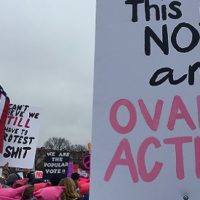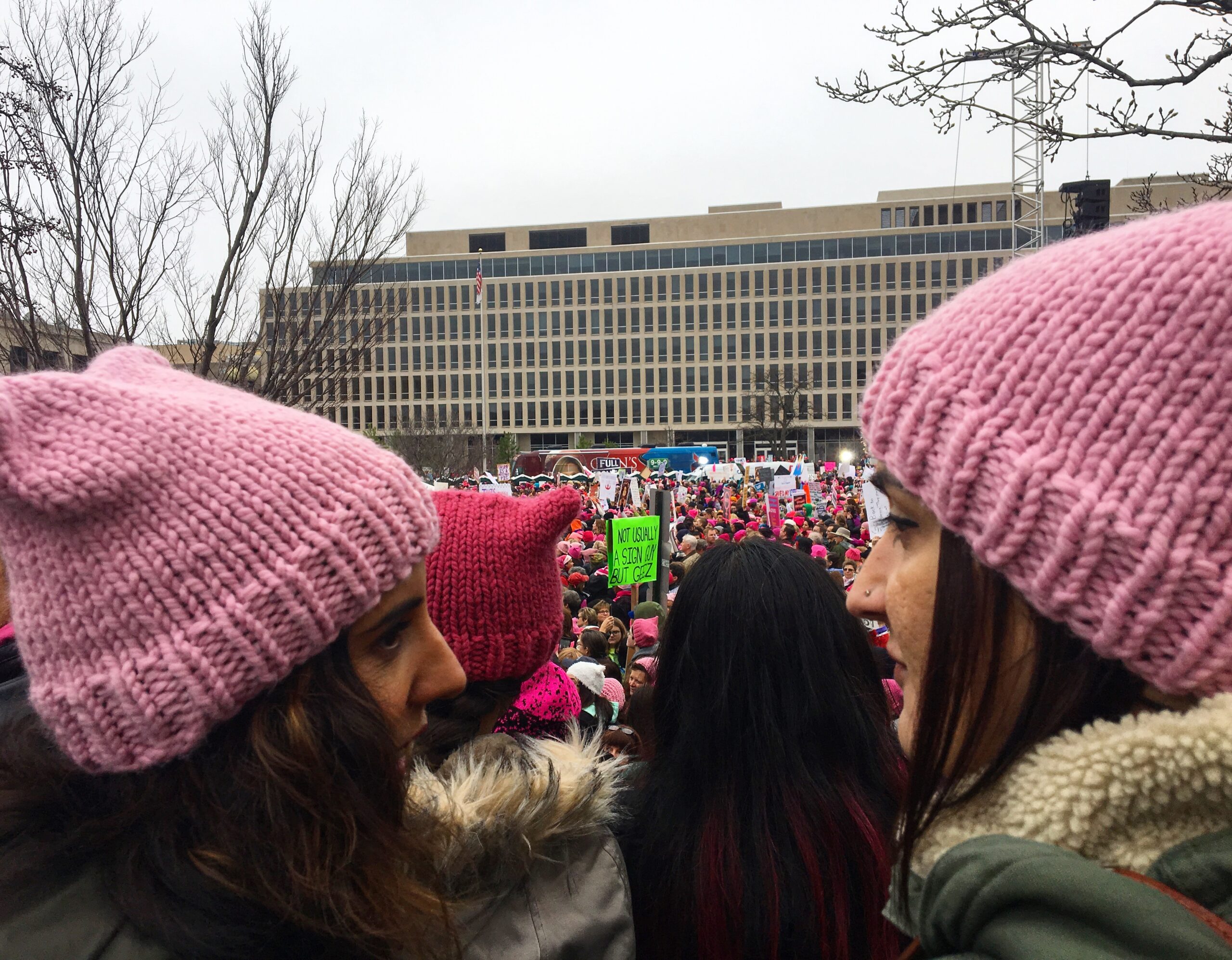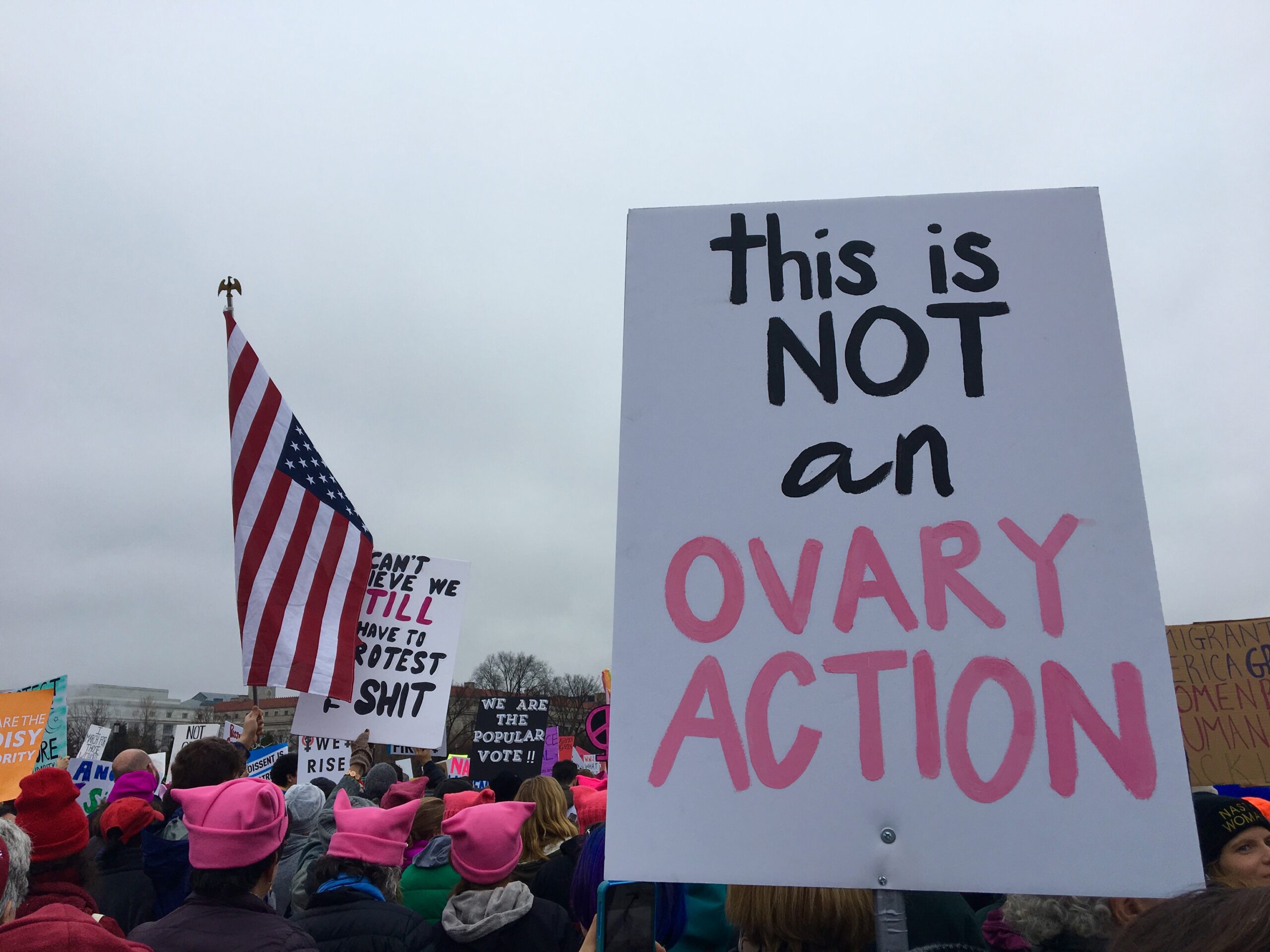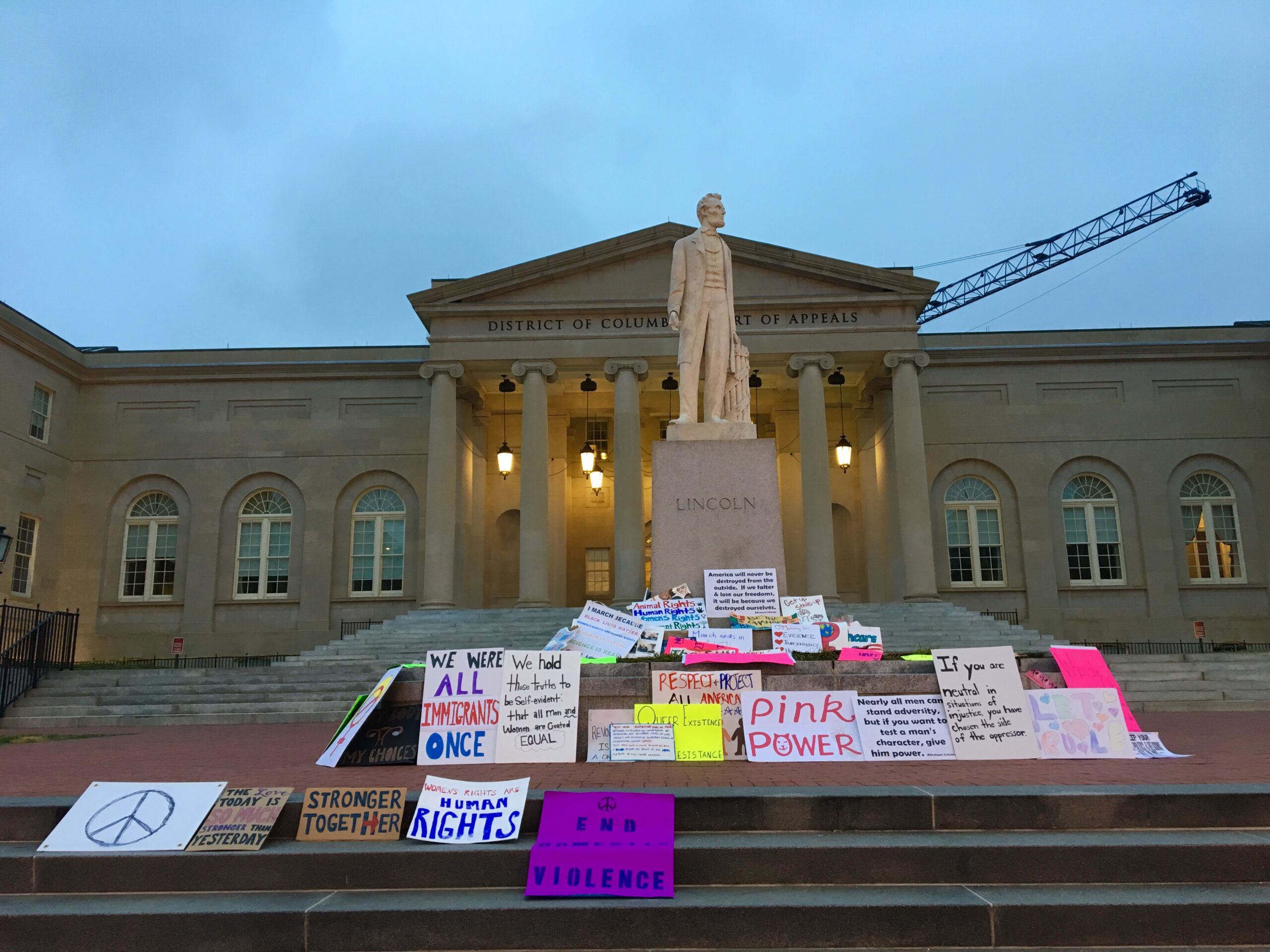The sun hadn’t risen and already women were gathering in the streets. They carried cups of coffee with their homemade signs, making their way to Independence Avenue along the southern edge of the National Mall, where in four hours the Women’s March on Washington was set to start. Granola bars and bananas showed through clear plastic backpacks—the march organizers’ had asked people to bring as little as possible and to store it in something see-through so police would know what each bag contained. There wasn’t anyone there to enforce this rule but most of the women seemed to have obeyed it anyway. “I read the instructions. I made a check-list of what to do: clear bag, nothing hard or pointy attached to my poster, plenty of snacks, I followed it all,” a woman named Lindsay who’d traveled from Chicago said. “I have a full time job, I have kids at home, but this is important and I’m going to do this right.” Written on her arm in sharpie was a phone number to call—also one of the instructions—in case something went wrong. “I don’t know what they think could happen,” she said. She, like most of the other women there, had never protested, never carried a sign for anything, before.
By 8 a.m. the National Mall was brimming with people. They spilled over onto nearby pavilions. They climbed trees. They sat on top of porter-potties. Someone blasted Lauryn Hill’s “Lost Ones”—“You might win some but you just lost one”—on a portable stereo. Near some trees, an elderly man stood quietly with a sign: “Old White Men Care Too.” Loudspeakers and oversized video screens projected speeches by Gloria Steinem and several celebrities. The actress America Ferrera, a first-generation American, said that as both a woman and a child of immigrants she found the past Presidential election especially hard to take. Planned Parenthood volunteers handed out petitions next to a group of women proclaiming themselves, “Gay. Feminist. Pro-Life.”
By mid-morning, the crowd had gotten so large and unwieldy that at times it became hard to move. People stood shoulder to shoulder as if they were in a particularly stuffed elevator or subway car, their pink knitted hats resting on each other’s shoulders. “Hey, Florida!” one woman called to another woman she’d met earlier in the very, very long line for the bathroom. Florida—a mid-forties blond woman in a pale pink sweatshirt who’d come in on a bus that morning from Jacksonville—had gotten separated from her friends.
“Your peeps are over there,” The woman shouted.
“Thanks, North Carolina!” Florida shouted back, and weaved through the crowd to find them. The plan was to march down Independence Avenue, across the Mall and stop at the White House. But the pre-approved, police-sanctioned route was full—was actually impassable because of too many people—that it became clear that a physical walk wouldn’t be possible.
“Where’s the march?” a man asked his friend.
“This is the march,” his friend replied, “We’re just not moving.”
Rumor spread that the crowd in Washington had swelled to over half a million people which, if true, would make it tone of the largest protests in American history.
Eventually, people stopped waiting for official instructions and set off to march on their own. They moved in all directions—across the Mall, toward the Capitol, over near the White House. Men and women started call-and-response chants. “Tell me what democracy looks like!” The male voices called. The response came high and loud and feminine: “This is what democracy looks like!”
Black Lives Matter posters waved next to “Jews Against Islamaphobia,” “Pussy Grabs Back,” and signs for equal pay. A preposterously large balloon globe bounced above the crowd, barely escaping collision with an anatomically accurate paper máchê vagina. Versus from “This Land Is Your Land” and “Lean On Me” rose and fell.
“I wish we could sing ‘Stand By Me,’ but we need bass and baritones,” one woman lamented, ‘It’s hard to find a baritone in a women’s march.”
Sometimes a pocket of empty space would open up and the crowd would surge to the left or the right, trying to find a place to move. At Constitution Avenue it started to open up. “Okay, ladies, now let’s get in formation!” a woman with green hair shouted, then charged with a mass of strangers towards the National Archives. What happened that day looked less like a march and more like an invasion. The nearby restaurants that stayed open saw lines of pink-hatted customers so long they wound out the door and down the street. The Farragut North metro stop was so backed up that people waited outside of it for a chance to enter. In one train car, women quietly, reverently sang “We Shall Overcome.” A dark-skinned college student looked around her and then turned to her friend: “I love us,” she said. The police guided traffic and offered directions, but for the most part stayed out of the way.
Most protests don’t work. Their problem is usually one of scale: not enough people show up. Other times things turn violent, and images of looted shops and smashed windows become the story instead. Or maybe the problem happens at the denouement. Every protests ends eventually and that’s when, after people are unchained from the Redwood trees, or agree to stop lying down in the street, the bulldozers come anyway and knock it all down. In 2011, Occupy Wall Street took over the parks and pavilions of 2,600 cities throughout the world. Magazines put them on covers. Reporters shared their message on the nightly news. But six years later, the new President is rolling back bank regulation and striking down a law requiring financial advisors to act in the best interest of their clients.
The next four years will be full of demonstrations and marches and homemade protest signs. Just one week after the Women’s March, thousands of people gathered outside major US airports to protest President Trump’s not-technically-a-Muslim-travel-ban. A few days after that, hundreds more danced for LGBTQ rights outside Greenwich Village’s Stonewall Inn. Google employees rallied at their offices. Muslim bodega owners closed up shop and prayed to Mecca in Brooklyn’s Borough Hall. Seventy-six people were arrested near the Standing Rock Sioux reservation for sitting on energy company land. A Berkeley opposition to a visiting Breitbart columnist turned so violent the school was temporarily put on lockdown. The night that Immigration and Customs Enforcement officials launched deportation raids in Southern California, people linked arms outside a detention center in downtown Los Angeles to form a human chain. Someone affixed a banner with the word “Resist” to a construction crane rising above the White House.
No one show of defiance can do all that much. It never has. Seven years elapsed between the first women’s march on Washington, by 5,000 suffragists in 1913, and the ratification of the Nineteenth Amendment, granting women the right to vote. In 1963 Martin Luther King looked upon 200,000 people gathered on the National Mall and delivered his most famous declaration, “I Have a Dream.” Even then, the Civil Rights Act didn’t pass for another year. The same, slow drag of progress is happening now. Supreme Court may strike down the travel ban, but the President says just issue something else, something worded to make it a little more legal. He still signed an executive order making it easier for companies to discriminate against gay and transgender people. ICE will still deport the undocumented. The Breitbart columnist is still out there, still claiming all Muslims are terrorists, still calling women who believe they’re equal to men ugly and fat.
The strength of a protest doesn’t lie in its ability to facilitate quick change. Its job is to hearten the people who’re part of it, to let them look into the eyes of those who agree with them, to help them feel less alone. It must be exhausting to be detained by a customs agent for hours, unsure of your paperwork, unsure when (or if) you’ll be allowed to leave, or how you’ll live, or where you’ll go. At John F. Kennedy Airport the night of the immigration ban was signed, a fifty-three-year-old Iraqi man who’d worked as an interpreter for the US military spent 19 hours in custody. He’d gone through a yearlong vetting process and held what had been a valid visa. When he was finally let go, free to enter America, he saw protesters and cried. “America is the greatest nation,” he told a television news reporter, “the greatest people in the world.”
Without a protest, without a physical presence, it’s hard to know how strong or numerous you really are. Most of the women surging through Washington’s streets are from good homes, they said. They had good families. Held good jobs. Many of them were white. They’d been sheltered by their comforts, their whiteness, their New York Times-reading Facebook friends. But something happened that tipped them over the edge. One woman said for her, the change came early on—the comment about how Hispanics were rapists. Another said she was there because her niece was in a wheelchair. She’d seen the video about the disabled reporter, she knew what those cocked, flailing arm gestures meant. The Access Hollywood tape came up again and again; when it came out these women thought, surely this is the end of him. Surely their country would never put up with that. On Election Night, they felt small. Unwanted. Alone.
By the evening, the official march had more or less dispersed but the women stayed in the city. They filled restaurants and clamored into bars, still in their hats, still with their signs. There had been little to no cell phone reception in the city that day and while it had been clear to those in the thick of it that the march had exceeded even the most hopeful of expectations, the protesters hadn’t yet been able to check the news. At P.J. Clark’s on K Street, the big-screen television screens atop the bar were tuned to CNN. When the network showed a four-way-split screen of marchers in cities across America, an audible gasp overtook the restaurant, followed by whoops and cheers. Senator Elizabeth Warren came on the screen and the cheers got louder. Gloria Steinem appeared and they got louder still. A Buffalo Springfield song played overhead in the restaurant while the TVs, their sound off, showed images of women flooding city streets around the world. “Oh my lord,” one woman said. She flagged the bartender down for more pinot grigio. Next to her, a woman in her 60s sat watching the news reports for a long time. “Women will stay tolerant of things they dislike for a long time,” she said. “But when they’ve finally had enough? Man, you better watch out.
***
Photographs provided courtesy of author.







